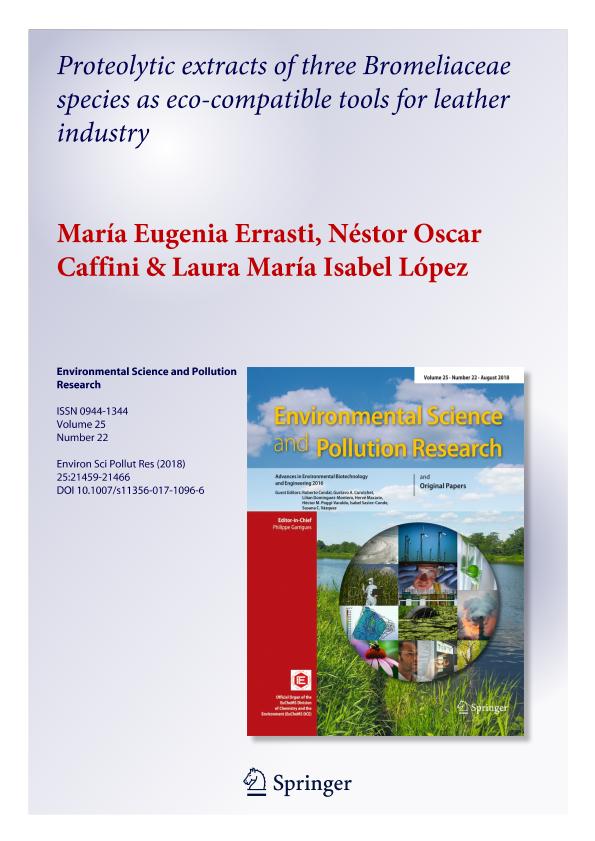Mostrar el registro sencillo del ítem
dc.contributor.author
Errasti, María Eugenia

dc.contributor.author
Caffini, Nestor Oscar

dc.contributor.author
Lopez, Laura Maria Isabel

dc.date.available
2019-10-08T18:55:39Z
dc.date.issued
2018-08
dc.identifier.citation
Errasti, María Eugenia; Caffini, Nestor Oscar; Lopez, Laura Maria Isabel; Proteolytic extracts of three Bromeliaceae species as eco-compatible tools for leather industry; Springer Heidelberg; Environmental Science and Pollution Research; 25; 22; 8-2018; 21459-21466
dc.identifier.issn
0944-1344
dc.identifier.uri
http://hdl.handle.net/11336/85358
dc.description.abstract
Most tanneries use high proportions of Na2S and CaO during the dehairing step, resulting in effluents of high alkalinity and large amounts of suspended solid, besides the risk of liberating the toxic H2S. Solid waste rich in protein is another environmental problem of tanneries. Enzymes are an interesting technological tool for industry due to their biodegradability, nontoxic nature, and nonpolluting effluent generation. In the leather industry, proteases have been chosen as a promising eco-friendly alternative to Na2S/CaO dehairing. Extracts with high proteolytic activity have been obtained from fruits of Bromeliaceae species: Bromelia balansae Mez (Bb), Bromelia hieronymi Mez (Bh), and Pseudananas macrodontes (Morr.) Harms (Pm). In this work, Bb, Bh, and Pm have been studied for application in the leather industry, focusing in their dehairing properties. Enzymatic activities were measured against collagen, keratin, elastin, and epidermis while a dehairing assay was performed by employing cowhide. All extracts showed similar activity on collagen and epidermis, while Bh and Pm were the most active against keratin at the same caseinolytic unit (CU) values; Bh was the only extract active against elastin. Bb (1 CU/ml), Bh (1.5 CU/ml), and Pm (0.5 CU/ml) were able to depilate cowhide. Desirable characteristics of dehairing were observed for all extracts since hair pores did not show residual hair, grain surface was clean and intact, and collagen fiber bundles of dermis were not damaged. In conclusion, results here presented show that proteolytic extracts of Bromeliaceae species are promising eco-compatible tools for leather industry.
dc.format
application/pdf
dc.language.iso
eng
dc.publisher
Springer Heidelberg

dc.rights
info:eu-repo/semantics/openAccess
dc.rights.uri
https://creativecommons.org/licenses/by-nc-sa/2.5/ar/
dc.subject
BROMELIACEAE
dc.subject
ENZYMATIC DEHAIRING
dc.subject
LEATHER
dc.subject
LIME AND SULFIDE-FREE DEHAIRING
dc.subject
PLANT PROTEASES
dc.subject
PROTEIN WASTE
dc.subject.classification
Bioprocesamiento Tecnológico, Biocatálisis, Fermentación

dc.subject.classification
Biotecnología Industrial

dc.subject.classification
INGENIERÍAS Y TECNOLOGÍAS

dc.title
Proteolytic extracts of three Bromeliaceae species as eco-compatible tools for leather industry
dc.type
info:eu-repo/semantics/article
dc.type
info:ar-repo/semantics/artículo
dc.type
info:eu-repo/semantics/publishedVersion
dc.date.updated
2019-09-27T14:35:57Z
dc.identifier.eissn
1614-7499
dc.journal.volume
25
dc.journal.number
22
dc.journal.pagination
21459-21466
dc.journal.pais
Alemania

dc.journal.ciudad
Heidelberg
dc.description.fil
Fil: Errasti, María Eugenia. Consejo Nacional de Investigaciones Científicas y Técnicas. Centro Científico Tecnológico Conicet - La Plata; Argentina. Instituto Nacional de Tecnología Industrial. Centro de Investigación y Desarrollo del Cuero. Provincia de Buenos Aires. Gobernación. Comision de Investigaciones Centíficas. Centro de Investigación y Desarrollo del Cuero; Argentina
dc.description.fil
Fil: Caffini, Nestor Oscar. Universidad Nacional de La Plata. Facultad de Ciencias Exactas. Departamento de Ciencias Biológicas. Laboratorio de Investigación de Proteínas Vegetales; Argentina
dc.description.fil
Fil: Lopez, Laura Maria Isabel. Consejo Nacional de Investigaciones Científicas y Técnicas. Centro Científico Tecnológico Conicet - La Plata; Argentina. Instituto Nacional de Tecnología Industrial. Centro de Investigación y Desarrollo del Cuero. Provincia de Buenos Aires. Gobernación. Comision de Investigaciones Centíficas. Centro de Investigación y Desarrollo del Cuero; Argentina
dc.journal.title
Environmental Science and Pollution Research

dc.relation.alternativeid
info:eu-repo/semantics/altIdentifier/url/https://link.springer.com/article/10.1007/s11356-017-1096-6
dc.relation.alternativeid
info:eu-repo/semantics/altIdentifier/doi/http://dx.doi.org/10.1007/s11356-017-1096-6
Archivos asociados
